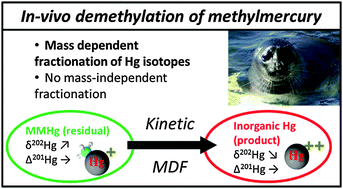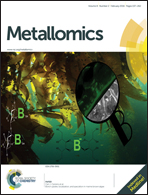Natural Hg isotopic composition of different Hg compounds in mammal tissues as a proxy for in vivo breakdown of toxic methylmercury†
Abstract
In the last decade, specific attention has been paid to total mercury (HgT) stable isotopic composition, especially in natural samples such as aquatic organisms, due to its potential to track the cycle of this toxic element in the environment. Here, we investigated Hg Compound Specific stable Isotopic Composition (CSIC) of natural inorganic Hg (iHg) and methylmercury (MMHg) in various tissues of aquatic mammals (Beluga whale from the Arctic marine environment and seals from the freshwater lake Baikal, Russia). In seals' organs the variation in mass dependent fractionation (MDF, δ202Hg) for total Hg was significantly correlated to the respective fraction of iHg and MMHg compounds, with MMHg being enriched by ∼3‰ in heavier isotopes relative to iHg. On the other hand, we observe insignificant variation in Hg mass independent isotope fractionation (MIF, Δ199Hg) among iHg and MMHg in all organs for the same mammal species and MMHg in prey items. MIF signatures suggest that both MMHg and iHg in aquatic mammals have the same origin (i.e., MMHg from food), and are representative of Hg photochemistry in the water column of the mammal ecosystem. MDF signatures of Hg compounds indicate that MMHg is demethylated in vivo before being stored in the muscle, and the iHg formed is stored in the liver, and to a lesser extent in the kidney, before excretion. Thus, Hg CSIC analysis in mammals can be a powerful tool for tracing the metabolic response to Hg exposure.


 Please wait while we load your content...
Please wait while we load your content...